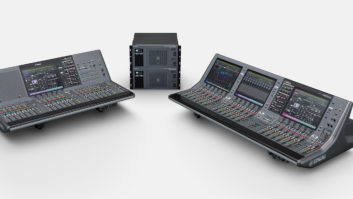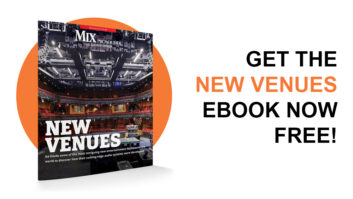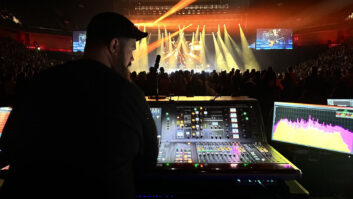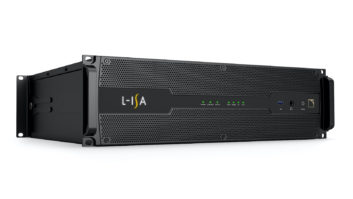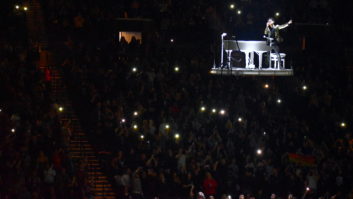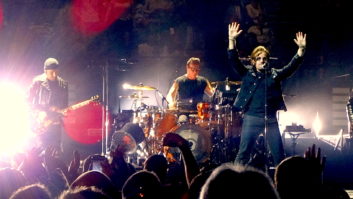A mainstay of metal since the mid-’90s, Godsmack spent most of 2019 on the road supporting its seventh studio album, 2018’s When Legends Rise, playing arenas, theaters, festivals and everything in between. Over the 18-month album cycle, the band took multiple jaunts around the world, playing U.S. dates with audio provided by UltraSound, and Europe with sound by Victory.
While engineer Scott Tkachuk started the journey in 2018, manning the FOH desk, he stepped away from the tour for part of 2019, returning to the fold for Godsmack’s fall U.S. arena run with Halestorm. The intervening 2019 legs saw the tour’s systems engineer/FOH tech Erik Rogers step in as FOH engineer.
No slouch behind the desk, having mixed the likes of Dustin Lynch, Ed Kowalczyk and others, Rogers ruled over 96 inputs on a Midas Pro X console each night, capturing the sound of a band that brings unpredictability to its shows: “There’s three downstage vocal positions, plus there’s one backup,” said Rogers. “When the stage goes dark, I have no idea where the singer is gonna go, and he doesn’t know where he’s gonna go until he’s on it! That’s an interesting challenge.”
Those vocal mics were Shure Axient wirelesses with Telefunken M80 capsules—an arrangement that won an unexpected road test along the way. “In Europe, we had a backup microphone with the capsule of another brand. That was cool because I wanted an opportunity to A/B it, and we did—by accident at soundcheck. Somehow the spare was swapped in at soundcheck and the difference was pretty stark; quite honestly, the Telefunken won, and we didn’t even know it was being tested. It was like, ‘This really is the best mic for his voice.’”
Related: Live Sound Pros Acquire UltraSound, by Clive Young, June 11, 2018

The guitars, meanwhile, were captured with a Shure SM57, a Royer R10 ribbon and a Radial JDI DI box each. The ribbons gave Rogers pause initially: “I inherited this show, and of course, if you didn’t put it together, you make it your own. I was hesitant to put a ribbon on these guitars because it’s already dark, heavy music, and a ribbon’s already a dark, heavy microphone. I was talked into trying the R10, which is an ‘equal in quality but half the cost’ version of the famous R101 that you’re afraid to take out of its briefcase in case you breathe on it wrong. I put the R10 on guitars in rehearsals, tried it out and was pleased to admit that my initial thoughts about a ribbon on that guitar were wrong, because honestly those channels are flat in my console. It sounds perfect!”
On a Godsmack tour, however, there’s one miking challenge to rule them all: the drums. The show featured two sizable drum kits requiring extensive miking; plus, every drum had a trigger keying the gate. The result was that each kit had upwards of 20 channels, and that didn’t even include the percussion rig based around a bongo, djembe, cymbals and more.
“We do have a drum solo with both kits and it’s intense,” said Rogers. “They’re playing off of each other, the percussion comes in, and the kits are automated to roll in front of the backline. Soon I’ve got guitars firing into these drum kits while they’re spinning and doing all this fun stuff, and the guys are playing away, and it’s a dynamic thing, not just a loud crash. There’s parts of the drum solo where you could have a cell phone conversation over it. It’s cool because, yes, it’s a rehearsed drum solo, so it’s not like it varies, but at the same time, they’re humans—and they play! You’ve gotta pay attention.”
Related: Shinedown Steps Up on Tour, by Steve Harvey, Sep. 5, 2019
The audience paid attention, too, thanks to a Meyer Sound Leo Family system anchored by Lyon linear line array loudspeakers. “It all comes together with that,” said Rogers. “It’s loud, it’s in your face, but it’s all detailed. You can hear the notes when he strums the guitar. You don’t just hear the ‘mud from the amplifier’ type thing.”
Of course, it didn’t hurt that Rogers’ mixing philosophy changed over the course of the tour as well: “I spent so much time in Europe this year that I got used to keeping it around 101 dB. When I was younger, I didn’t care about how loud I was gonna get out there. I wanted the big, loud rock show. But honestly—and people may disagree—the rules in Europe are not unreasonable most of the time. There’s a couple of places where you roll your eyes and you get through it, but there’s nothing wrong with your limit being 100 dB at 180 feet from the stage. With Godsmack, I was nice and reasonable in Europe; then we got back, went out with Volbeat and I was getting right back up there—and that’s when I found it’s a struggle to actually pick out some of the nuance when you’re fatigued by the end of the night. Now I keep the show around 101, with 103 peaks. It’s not a loud, uncomfortable show. I haven’t had anyone come up to me and ask for hearing protection in a long time, and that’s kind of cool.”
There’s value to nuance; after all, it’s what the audience came to see. “One of the things important to me is, if I see an instrument being played on stage, I want to hear it,” said Rogers. “It really annoys me when you see a giant drum kit and all you hear is kick, snare, hat—or when you see a band with somebody singing into a microphone and he’s not there. He’s singing for a reason—he’s part of the song, the band wants him there, the guys are pretty talented and people paid a lot of money to hear that person. Let’s listen to them.”
FOH engineers can do a lot to shape a band’s music live and supercharge that connection between an act and its audience, but ultimately the energy starts with the musicians on stage—which is why Rogers’ favorite song to mix is always the one where the lights go down. “The first song sets the pace for the night,” he said. “It’s always the same song, but it sets the tone for the evening. How will they come out? I have no idea what they talked about in the dressing room, what they’re thinking or how they’re feeling, and you read the energy of the whole show right away. By the first word of the first song, you’ve taken the temperature and away you go!”
UltraSound • www.ultrasound.audio
Meyer Sound • www.meyersound.com

